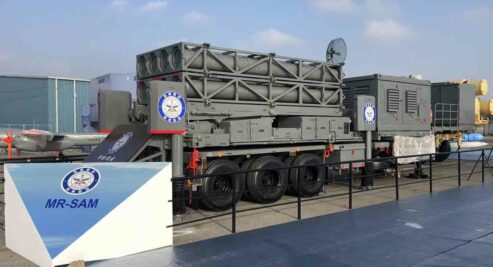Explainer: Army version of Medium Range Surface to Air Missile
Hyderabad: On March 27, the Defence Research and Development Organisation (DRDO) conducted two successful flight tests of the Army version of Medium Range Surface to Air Missile (MRSAM) at the Integrated Test Range, Chandipur, off the coast of Odisha. The tests were part of the live firing trials against high-speed aerial targets. The first launch […]
Updated On - 18 January 2025, 01:11 PM
Hyderabad: On March 27, the Defence Research and Development Organisation (DRDO) conducted two successful flight tests of the Army version of Medium Range Surface to Air Missile (MRSAM) at the Integrated Test Range, Chandipur, off the coast of Odisha.
The tests were part of the live firing trials against high-speed aerial targets. The first launch was to intercept a medium-altitude long-range target and the second launch was for providing capability of a low-altitude short-range target. The maiden test of the Medium Range Surface to Air Missile (MRSAM) for the Indian Army was conducted in 2020.
Army Variant of MRSAM
It is a surface to air missile developed jointly by DRDO, India and Israel Aerospace Industries (IAI), Israel for use by the Indian Army. It consists of a command and control post, multi-function radar and mobile launcher system.
MRSAM
It is a high-response, quick reaction, vertically launched supersonic missile, designed to neutralize enemy aerial threats – missiles, aircraft, guided bombs, helicopters. Supersonic missiles exceed the speed of sound (Mach 1) but they are not faster than Mach-3. It is used by the Army, Navy and Air Force as different variants.
In May 2019, Indian Navy, DRDO and IAI conducted the maiden co-operative engagement firing of the naval version of the MRSAM. It is a land based variant of the Barak Air and Missile Defence System (AMD).
India buys Barak AMD from Israel, it was designed and developed by Israel to protect its economic zones and strategic facilities from various threats.
Working of the missile
The missile’s management system uses the radar to track and correctly identify the target, calculates the distance from it and gives all the information to the Commander for a decision to be made on interception.
The missile itself is 4.5 metres in length with a weight of around 275 kg. It is equipped with fins and canards to stabilise its flight and provide it manoeuvrability.
The missile is powered by a solid propulsion system coupled with a thrust vector control system. It can engage multiple targets up to a range of 70 km.
DRDO
Defence Research and Development Organisation (DRDO) works under the administrative control of the Ministry of Defence, Government of India. It is working to establish world-class science and technology base for India and provides our Defence Services decisive edge by equipping them with internationally competitive systems and solutions. Dr G. Satheesh Reddy is the incumbent Chairman of DRDO.

DRDO was established in 1958 after combining the Technical Development Establishment (TDEs) of the Indian Army and the Directorate of Technical Development & Production (DTDP) with the Defence Science Organisation (DSO).
Starting with 10 laboratories, DRDO has now grown to a network of 52 laboratories that are deeply engaged in developing defence technologies covering various disciplines, like aeronautics, armaments, electronics, combat vehicles, engineering systems, instrumentation, missiles, advanced computing and simulation, special materials, naval systems, life sciences, training, information systems and agriculture. Presently, the Organisation is backed by over 5000 scientists and about 25,000 other scientific, technical and supporting personnel.
Now you can get handpicked stories from Telangana Today on Telegram everyday. Click the link to subscribe.
Click to follow Telangana Today Facebook page and Twitter .